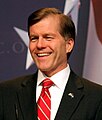University of Notre Dame
The University of Notre Dame du Lac, known simply as Notre Dame (/ˌnoʊtərˈdeɪm/ NOH-tər-DAYM; ND), is a private Catholic research university in Notre Dame, Indiana.[7] French priest Edward Sorin founded the school in 1842. The main campus of 1,261 acres (510 ha) has a suburban setting and contains landmarks such as the Golden Dome, the Word of Life mural, Notre Dame Stadium, and the Basilica. Originally for men, the university started accepting undergraduate women in 1972.[8]
For other universities and colleges named "Notre Dame", see Notre Dame (disambiguation).
Notre Dame is one of the top universities in the United States.[9][10][11][12][13] The university is organized into seven schools and colleges. Notre Dame's graduate program includes more than 50 master, doctoral and professional degrees offered by the six schools, including the Notre Dame Law School and an MD–PhD program offered in combination with the Indiana University School of Medicine.[14][15] The School of Architecture is known for teaching New Classical Architecture and for awarding the annual Driehaus Architecture Prize.
The university offers more than 50 semester and year-long study programs abroad and over 15 summer programs.[16] Notre Dame maintains a system of libraries, cultural venues, artistic and scientific museums, including the Hesburgh Library and the Snite Museum of Art. Most of the university's 8,000 undergraduates live on campus in one of 33 residence halls. Notre Dame's network of alumni consist of 151,000 members.[17]
The university's athletic teams are members of the NCAA Division I and are known collectively as the Fighting Irish. Notre Dame is noted for its football team, which contributed to its rise to prominence on the national stage in the early 20th century; the team has no conference affiliation and has accumulated 11 consensus national championships, 7 Heisman Trophy winners, 62 members of the College Football Hall of Fame, and 13 of the Pro Football Hall of Fame.[18] Notre Dame teams in other sports, chiefly in the Atlantic Coast Conference, have won 17 national championships.[19]
Notre Dame became more prominent in the early 20th century, aided by the success of its football team under coach Knute Rockne. Major improvements to the university occurred during Theodore Hesburgh's administration between 1952 and 1987. His administration increased the university's resources, academic programs, and its reputation. Notre Dame's growth has continued in the 21st century. At the end of the fiscal year 2022, its endowment was valued at $20.3 billion.[20]
Location
Off I-80/90, Notre Dame, Indiana
70 acres (28 ha)
1842
Mixed (more than two styles from different periods)
May 23, 1978
Undergraduate admissions statistics
12.9%
60%
1460-1540
33–35
38
20
12
32
401–500
304=
199=
322
Research[edit]
Science[edit]
Joseph Carrier, director of the Science Museum and the library, was a professor of chemistry and physics until 1874. Carrier taught that scientific research and its promise for progress were not antagonistic to the ideals of intellectual and moral culture endorsed by the Catholic Church. One of Carrier's students, John Augustine Zahm, was made professor and co-director of the science department at 23; by 1900, he was a nationally prominent scientist and naturalist. He was active in the Catholic Summer School movement, which introduced Catholic laity to contemporary intellectual issues. His book Evolution and Dogma (1896) defended certain aspects of evolutionary theory as true, and argued, moreover, that even the great church teachers, Thomas Aquinas and Augustine, taught something like it. The intervention of Irish American Catholics in Rome prevented Zahm's censure by the Vatican. In 1913, Zahm and former President Theodore Roosevelt embarked on a major expedition through the Amazon.[222]
In 1882, Albert Zahm, John's brother, built an early wind tunnel to compare lift to drag of aeronautical models. Around 1899, Professor Jerome Green became the first American to send a wireless message.[223] In 1931, Julius Nieuwland performed early work on basic reactions that were used to create neoprene.[224] The study of nuclear physics at the university began with the building of a nuclear accelerator in 1936,[225] and continues now partly through a partnership in the Joint Institute for Nuclear Astrophysics.[226]
The school has over 130,000 alumni and 275 alumni clubs around the world.[350][351] Notre Dame is ranked among the universities with strongest alumni networks.[352] Many give the university yearly monetary support. Notre Dame is ranked among schools with the highest alumni donation rates.[353] A school-record of 53.2 percent of alumni donating was set in 2006.[354] Many buildings, including residence halls, on campus are named for major donors.[355][356] Classroom buildings,[357] and the performing arts center are also named for donors.[104]
Alumni working in politics include state governors,[358] members of the United States Congress,[359] and former United States Secretary of State Condoleezza Rice.[360] Notable alumni from the College of Science are Eric F. Wieschaus, winner of the 1995 Nobel Prize in medicine,[361] and Philip Majerus, discoverer of the cardioprotective effects of aspirin.[362] Many university officials are alumni, including the current president, John Jenkins and incoming President Robert Dowd, a professor of Political Science who specializes in African Studies.[363][364] Alumni in media include talk show hosts Regis Philbin[365] and Phil Donahue,[366] and television and radio personalities such as Mike Golic[367] and Hannah Storm.[368] A number of sports alumni have continued their careers in professional sports, such as Joe Theismann, Joe Montana,[369] Tim Brown, Ross Browner, Rocket Ismail, Ruth Riley, Jeff Samardzija,[370] Jerome Bettis, Justin Tuck, Craig Counsell, Skylar Diggins-Smith, Brett Lebda, Olympic fencing gold medalist Mariel Zagunis and bronze medalist Nick Itkin, professional boxer Mike Lee, former football coaches such as Charlie Weis,[371] Frank Leahy and Knute Rockne,[372] and Basketball Hall of Famers Austin Carr and Adrian Dantley. Other notable alumni include prominent businessman Edward J. DeBartolo Jr. and astronaut Jim Wetherbee.[373][374] Two alumni have received the Presidential Medal of Freedom (Alan Page and Edward J. DeBartolo Jr.), and two the Congressional Gold Medal (Thomas Anthony Dooley III and Bill Hanzlik).



























